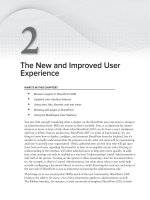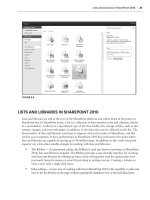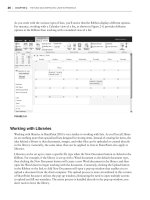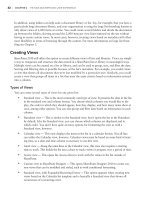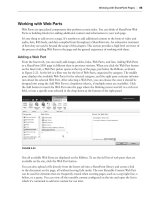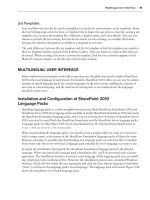Thủ thuật Sharepoint 2010 part 77 ppt
Bạn đang xem bản rút gọn của tài liệu. Xem và tải ngay bản đầy đủ của tài liệu tại đây (2.54 MB, 22 trang )
558
CHAPTER 19 the office WeB aPPlicatioNs
Feature Activation
Each site collection that will host the OWA functionality needs to be confi gured. This is accomplished
by activating the OWA feature. The activation process can be done manually by browsing to each
and every site collection’s Site Collection Features page and activating the feature or by running a
Windows PowerShell script. It is also possible to activate the feature for every site collection in the
farm at once using a PowerShell script.
OWA INSTALLATION
The following installation instructions assume that SharePoint Server 2010 has not been installed
yet, or that you have begun the installation but have not yet run the Confi guration Wizard. If you
have already run the Confi guration Wizard, proceed to the “OWA PowerShell Activation” section
at the end of the chapter.
Single-Server Farm Install
Install SharePoint Server 2010 according to the instructions in Chapter 4 and using the settings
described earlier for the Server Farm and Complete Install options. In the dialog shown in Figure 19-3,
leave the checkbox to automatically run PSConfi g blank. This will postpone running PSConfi g; the
administrator may choose to run it later after the OWA are installed.
Installing the O ce Web Applications
1. Make sure the user performing the installation is logged on with the built-in administrator
account.
2. Extract the OWA fi les to a folder on your system by using the /extract:c:\OWAfiles
switch, where
c:\OWAfiles is the location to extract the fi les.
3. At the root of the OWAfile folder, run the OWA setup application setup.exe, which will
display the Enter your Product Key dialog, shown in Figure 19-4.
4. After your key has been verifi ed, click Continue to display the Microsoft Software License
Terms dialog. Check the box to accept the terms and then click Continue.
5. On the Choose a fi le location dialog, shown in Figure 19-5, click Install Now to install to the
default location. The Installation Progress dialog will be displayed during the installation.
6. The setup process should take only a few minutes. Once it is complete, the Run Confi guration
Wizard dialog (refer to Figure 19-3) will be displayed. Be sure that the “Run the SharePoint
Products and Technologies Confi guration Wizard now” checkbox is selected, and then click
Close to start the confi guration wizard.
Step 6 assumes that the SharePoint Post-Setup Confi guration Wizard has not
been run after the original SharePoint server setup. If the wizard has already
been run, then the OWA services need to be created and activated, either man-
ually as described in Chapter 7 or using the PowerShell scripts provided at the
end of this chapter.
OWA Installation
559
FIGURE 194
FIGURE 195
7. The configuration wizard’s Welcome to SharePoint Products page, shown in Figure 19-6, is
displayed. Click Next to continue.
8. The next dialog notifies you that some services might need to be restarted or reset during
configuration. Click Yes to continue.
560
CHAPTER 19 the office WeB aPPlicatioNs
FIGURE 196
9. The Connect to a server farm dialog (see Figure 19-7) is shown next. Make sure the Create a
new server farm option is selected, and then click Next.
FIGURE 197
10. The Specify Configuration Database Settings dialog (see Figure 19-8) appears. Enter the appro-
priate value for the name of the database server, accept the default configuration database name
or enter your own choice, enter the access account information for the administrator account,
and click Next.
OWA Installation
561
FIGURE 198
11. The Specify Farm Security Settings dialog shown in Figure 19-9 asks you to enter a passphrase.
The purpose of the passphrase is to ensure that no other SharePoint servers can join the farm
unless they have the proper credentials. Enter whatever you like here or enter something like the
administrator account password. You can change this password later if you choose.
FIGURE 199
562
CHAPTER 19 the office WeB aPPlicatioNs
12. Figure 19-10 shows that the administrator can define a specific port for the Central
Administration web application or utilize a randomly generated port number. The option
to choose NTLM or Kerberos is also presented. It is usually best to choose Kerberos for
SharePoint web sites but NTLM will suffice for the administration web site. Enter the
appropriate information and click Next.
FIGURE 1910
13. The next screen, shown in Figure 19-11, summarizes the information that you entered.
Review the information and click either Next to begin the configuration process or Back
to make any changes.
FIGURE 1911
OWA Installation
563
14. The Confi guring SharePoint Products screen displays the progress for the confi guration pro-
cess. Once confi guration is complete, you will receive confi rmation stating that the confi gura-
tion was successful. Click Finish on the Confi guration Successful dialog to display the Central
Administration dialog shown in Figure 19-12. This completes the confi guration.
FIGURE 1912
Open SQL Server Management Studio and view the two different databases that
have been created, SharePoint_Confi g and SharePoint_Admincontent, which
represent the confi guration database and the Central Administration web site
databases, respectively.
Service Activation
From the Central Administration web site, click the “Manage servers in this farm” link located beneath
the System Settings heading to see the Servers in Farm information shown in Figure 19-13. You can see
that SharePoint Server 2010 and the Offi ce Web Applications are installed. The next step is to create
and confi gure the necessary services to support the web applications. You can do this task using the
Farm Confi guration Wizard, via manual confi guration, or using PowerShell commands.
564
CHAPTER 19 the office WeB aPPlicatioNs
FIGURE 1913
The following steps take you through the Farm Confi guration Wizard. This procedure must be
completed only if the wizard has not been previously run. If the wizard has already been run, the
OWA can be activated using the PowerShell scripts at the end of the chapter.
You can also confi gure the services manually. See the “Manual Activation” section
earlier in this chapter.
1. On the SharePoint Central Administration home page, click the Confi guration Wizards
hyperlink in the lower right-hand corner of the page. On the Confi guration Wizards page,
shown in Figure 19-14, click Launch the Farm Confi guration Wizard hyperlink.
2. The Farm Confi guration Wizard welcome page is shown in Figure 19-15. Choose “Walk me
through the settings using this wizard,” and then click Next.
3. The purpose of running the wizard is to confi gure the desired services. On the Confi gure
your SharePoint Farm page, in the Service Account section, make sure “Create new managed
account” is selected and type a username and password for the service account. If you have
not previously created an account specifi cally for services, then create the following account
in Active Directory for use as your service account:
contoso\sp_admin.
OWA Installation
565
FIGURE 1914
FIGURE 1915
566
CHAPTER 19 the office WeB aPPlicatioNs
4. The contents of the Configure your SharePoint farm web page are shown in Figure 19-16 and
Figure 19-17. In the Services section, select as many services as you would like, but specifically
ensure that the PowerPoint service application and the Word Viewing Service checkboxes are
selected. For this install, select all the checkboxes except the one for the Lotus Notes Connector
and then click Next.
FIGURE 1916
The next screen displayed indicates that processing is in progress. Service instances and
their corresponding proxies are being created during this time.
5. At this point, the services have been created and the administrator now has the option to create
a new top-level web site. On the Create Site Collection page, shown in Figure 19-18, add the
necessary information and click OK when you are finished.
6. On the Configure your SharePoint Farm page, shown in Figure 19-19, review the list of
services and click Finish.
This completes the OWA setup. Next you will proceed with testing the web applications to ensure
they are working.
The installed service application instances can be viewed from the Manage Service Applications
web page in Central Administration. Make sure that the PowerPoint service application and proxy
instances are listed and the services are started. Also, make sure the Word Viewing Service and
proxy instances have been created and started.
OWA Installation
567
FIGURE 1917
FIGURE 1918
568
CHAPTER 19 the office WeB aPPlicatioNs
FIGURE 1919
Feature Activation and OWA Testing
The last step in the installation and configuration is to activate the Office Web Apps feature at the
site collection level and ensure that the apps are functioning properly.
1. Using the newly created site collection as the test case, navigate to the Features page for the
site collection and confirm that the Office Web Apps feature has been activated, as shown in
Figure 19-20.
FIGURE 1920
2. The administrator should also confirm that the Shared Documents library that has been
provisioned as part of the new web site in the site collection has been configured to open
documents in the browser by default, as shown in Figure 19-21. Do this by navigating to the
Advanced Settings page for the Shared Documents library.
OWA Installation
569
FIGURE 1921
3. Add a document to the Shared Documents library so that the View in Browser functionally
can be tested. You can do this by either creating a new document from scratch and then sav-
ing the document to the Shared Documents library or uploading a document to the library
directly. Then select the View in Browser menu option from the drop-down menu, as shown
in Figure 19-22. This will open the document in the web browser using the Office Web
Application functionality.
FIGURE 1922
4. If everything has been configured properly, the Word document will open in the browser (see
Figure 19-23), indicating that the Word web application is functioning properly. The browser
may also display the banner shown here above the document, indicating that the Word view-
ing experience can be improved by installing the Silverlight plug-in. To do so, click the link and
complete the steps on the corresponding web pages.
570
CHAPTER 19 the office WeB aPPlicatioNs
FIGURE 1923
You should test the Excel and PowerPoint web applications in the same way to confi rm that they are
confi gured properly.
If the OWA have been installed on a single server that is also functioning as an Active Directory
domain controller, you will likely encounter the error shown in Figure 19-24. To fi x the error and
complete the confi guration of the Word web application, you need to run the PowerShell commands
using the following steps.
1. Open the SharePoint 2010 Management Shell from the Start menu in the Microsoft
SharePoint 2010 Products heading. Type and execute the following two sets of commands:
See Chapter 10 for a refresher on running PowerShell commands.
Get-SPServiceApplication
$e = Get-SPServiceApplication | where {$_.TypeName.Equals(“Word
Viewing Service Application”)}
$e.WordServerIsSandboxed = $false
$e.WordServerIsSandboxed
Code fi le Chapter19_code.txt
OWA Installation
571
FIGURE 1924
The first command, Get-SPServiceApplication, will provide a list of the installed service
application instances. This command needs to be run first so that the correct names of the ser-
vice application instances can be determined. Keep in mind that in different languages, service
application names could be localized. These service application names are then utilized in the
second set of PowerShell commands. In this case, the Word Viewing Service and PowerPoint
service application are the services of interest.
2. Type and execute the following two PowerShell commands to activate the PowerPoint service
application. Respond to the prompts with a “Y” for yes after each command is executed, as
shown in Figure 19-25. (Each of these commands belongs on a single line; they are broken
here to fit on the page.)
Get-SPPowerPointServiceApplication | Set-SPPowerPointServiceApplication -
EnableSandboxedViewing $false
Get-SPPowerPointServiceApplication | Set-SPPowerPointServiceApplication -
EnableSandboxedEditing $false
572
CHAPTER 19 the office WeB aPPlicatioNs
FIGURE 1925
3. Navigate to the following location:
c:\windows\system32\inetsrv\config\applicationHost.config
Add the following XML to the end of the dynamicTypes section:
<add mimeType=”application/zip” enabled=”false” />
4. Execute an IISRESET command.
This completes the manual confi guration necessary to activate the OWA on a server that is also
functioning as a domain controller. Proceed with testing the Excel and PowerPoint web applications
to ensure that they are functioning properly.
Keep in mind that installing the OWA on a domain controller is not a supported
confi guration for a production environment. It is to be used as a development
environment only.
PowerPoint Broadcast Slide Show
The Offi ce 2010 Broadcast Slide Show (BSS) capability enables presenters to broadcast a PowerPoint
2010 slide show to remote users who can view the slide show using their web browser. The BSS service
is hosted on a SharePoint server with the OWA installed and utilizes the PowerPoint service applica-
tion. You create one or more broadcast services by creating sites that use the PowerPoint Broadcast site
template, and set permissions for those individuals who can use the service through group membership
on the site.
Installation and Confi guration
The BSS requires that the PowerPoint service application be created and started. As demonstrated
earlier, this is accomplished by running the Farm Confi guration Wizard after the OWA have been
OWA Installation
573
installed. OWA installation adds the PowerPoint Broadcast site template to the server. A SharePoint site
collection created from this template is required to utilize the BSS capability. Users who will utilize the
BSS connect to the URL of this site collection to start a broadcast, and attendees also utilize this link to
view the presentation in their browser. Multiple BSS sites may be created, each with its own URL.
As part of the OWA installation, a default BSS site collection is created within the default web
application at
http://<default web application>/sites/broadcast, which may be this URL:
http://<server name>/sites/broadcast, where <server name> refers to the name of the server.
In our specific installation, Figure 19-26 displays this default site collection’s home page.
FIGURE 1926
Specific SharePoint groups are automatically created to help manage user access permissions. You
can view these groups by clicking the Groups hyperlink on the left-hand side of the site, as shown
in Figure 19-27. The groups include the following: Broadcast Administrators, Broadcast Presenters,
Broadcast Attendees, and Broadcast Content Access Users. The Windows group NT Authority/
Authenticated Users is automatically added to the Broadcast Presenters and Broadcast Attendees
groups of this default site, granting all users access to create and view broadcasts. Also notice that
the Administrator account is added to the Broadcast Administrators group.
574
CHAPTER 19 the office WeB aPPlicatioNs
FIGURE 1927
BSS sites can also be created manually by creating a new site collection using the PowerPoint Broadcast
Site template as described in the following steps.
1. From the Central Administration web site home page, click the Create site collections hyperlink.
This displays the Create Site Collection page shown in Figure 19-28.
2. Create a new site collection using the PowerPoint Broadcast Site template, which is located
on the Enterprise tab of the Template Selection section, shown in Figure 19-29. Once the new
site collection has been created, the administrator should confirm that no permissions are
granted by default, and assign permissions manually.
3. The broadcast site administrator must assign users permissions to broadcast and attend slide
show broadcasts as recommended below. Permission assignment is done from the People and
Groups web page (refer to Figure 19-27).
Users who need to broadcast should be added to the Broadcast Presenters group.
Users who need to attend a broadcast should be added to the Broadcast
Attendees group.
Users who need to administer the site and change group membership should be
added to the Broadcast Administrators group.
OWA Installation
575
FIGURE 1928
FIGURE 1929
Once security is configured, the broadcast service needs to be made available to individual
PowerPoint 2010 users. Presenters can connect to the site and start a broadcast from their
desktop PowerPoint 2010 application, and viewers can see the presentation from their
browsers. Group policy can also be used to advertise the service to users so they don’t need
to enter the broadcast site URL manually. Those interested in using group policy should
download the PowerPoint 2010 Administrative template and follow the instructions in
the article “Enforce settings by using Group Policy in the 2007 Office System,” located at
Group policy can
also be used to disable the broadcast capability.
576
CHAPTER 19 the office WeB aPPlicatioNs
4. Open a PowerPoint slide deck. On the Slide Show tab, click the Broadcast Slide Show button
on the ribbon to display the Broadcast Slide Show dialog, shown in Figure 19-30.
FIGURE 1930
5. Click the Change Broadcast Service button, and then click the Add a new service… link. Type
the URL of the new site in the Add Broadcast Service dialog and click the Add button. The result
of adding the
http://sharepoint2010/sites/broadcast site is shown in Figure 19-31.
6. Click the Start Broadcast button. The Connecting to SharePoint2010 dialog will appear as
shown in Figure 19-32.
7. The final screen before starting the slide show provides the presenter with an option to copy
the URL of the broadcast site or send an e-mail so that attendees can be informed. This
screen is shown in Figure 19-33. To start the slide show, click the Start Slide Show button.
8. The slide show should begin, as shown in Figure 19-34. The presenter can press the Escape
key to exit the presentation but won’t be able to edit it until the broadcast is ended. This
completes the configuration.
OWA Installation
577
FIGURE 1931
FIGURE 1932
578
CHAPTER 19 the office WeB aPPlicatioNs
FIGURE 1933
FIGURE 1934
OWA PowerShell Activation
579
Multiple-Server Farm Install
The multiple-server install process is exactly the same as the single-server install except that the
setup application must be executed on every server in the server farm that will host the Office Web
Application functionality. The other difference is that the PowerShell commands for activating the
services on a single server that is also a domain controller may not need to be executed because in a
multiple-server install the domain controller is usually a separate physical server.
OWA POWERSHELL ACTIVATION
PowerShell commands can also be used to create and activate the OWA service applications.
The PowerShell commands can be executed from any server in the farm that has the OWA
installed. SharePoint administrators are likely to be only now becoming familiar with PowerShell,
as SharePoint 2010 is the first SharePoint version to recommend use of the technology.
PowerShell Permissions
Historically, SharePoint administrators have used Central Administration and the command-line
tool STSADM for administering the SharePoint farm. One of the challenges of using these tools was
the specific permissions that were required.
The SharePoint administrator needed to be a Farm Administrator to access the Central Administration
(CA) web site; this meant that the administrator had to be a member of the Farm Administrators
Group. This membership gave the administrator access to use the CA web site to execute operations
against the configuration database through the CA web application. These operations were executed
in the security context of the application pool account for the web application, not the administrator.
This situation differs with the STSADM command environment and PowerShell.
STSADM and PowerShell commands are run in the security context of the user executing the com-
mands. The good news is that this enables commands to be run from any server in the farm because
CA is not required. The challenge is that this requires the user to have the necessary permissions to
complete the operation the commands are implementing. With STSADM, the user is required to be
a local administrator, a SharePoint Farm Administrator, and have specific SQL Server permissions.
In general, PowerShell simplifies this because the administrator or user who is executing the PowerShell
commands against the SharePoint 2010 farm only requires PowerShell and SQL Server permissions.
Obviously, because each PowerShell command utilizes the SharePoint object model, additional permis-
sions may be necessary for specific PowerShell commands, such as installing SharePoint 2010, Windows
file system manipulation, and registry changes. Therefore, in general, administrators need to have the
following two permissions to execute PowerShell commands:
The user must be a member of the Windows group WSS_ADMIN_WGP on the server being
used to execute the commands.
The user must be a member of the SQL Server role called SharePoint_Shell_Access on the
configuration database.


